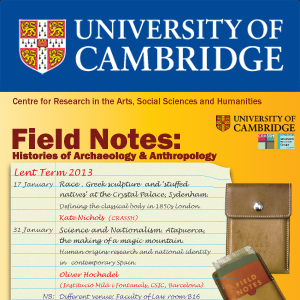Field Notes - 28 October 2013 - People and Places: Late C20th
Duration: 47 mins 40 secs
Share this media item:
Embed this media item:
Embed this media item:
About this item

| Description: |
People and Places Reading Group: Experts, Politicians, Labs and Media in Late Twentieth-Century Palaeoanthropological Knowledge Production
Miquel Carandell Baruzzi (Universitat Autònoma de Barcelona) Abstract Our Michaelmas reading group develops from Miquel’s interest in the ‘Orce man’ controversy that arose over a cranial fragment discovered in 1982 in Orce, Granada that initially appeared to be from a hominid but was later attributed to a donkey’s remains. In this session, Miquel will trace how paleoanthropological knowledge is “constructed” by different actors (academic experts, politicians, journalists) in excavation sites, laboratories, conferences and the modern media. Seeking a better understanding of the strategies used by scientists in this process, we will discuss how it is possible to analyse and begin to frame the construction of paleoanthropology as a scientific discipline at the end of the twentieth century. |
|---|
| Created: | 2013-10-29 11:07 |
|---|---|
| Collection: | Field Notes Seminar |
| Publisher: | University of Cambridge |
| Copyright: | Glenn Jobson |
| Language: | eng (English) |
| Keywords: | CRASSH; Field Notes; |
| Abstract: | People and Places Reading Group: Experts, Politicians, Labs and Media in Late Twentieth-Century Palaeoanthropological Knowledge Production
Miquel Carandell Baruzzi (Universitat Autònoma de Barcelona) Abstract Our Michaelmas reading group develops from Miquel’s interest in the ‘Orce man’ controversy that arose over a cranial fragment discovered in 1982 in Orce, Granada that initially appeared to be from a hominid but was later attributed to a donkey’s remains. In this session, Miquel will trace how paleoanthropological knowledge is “constructed” by different actors (academic experts, politicians, journalists) in excavation sites, laboratories, conferences and the modern media. Seeking a better understanding of the strategies used by scientists in this process, we will discuss how it is possible to analyse and begin to frame the construction of paleoanthropology as a scientific discipline at the end of the twentieth century. |
|---|---|

